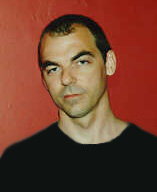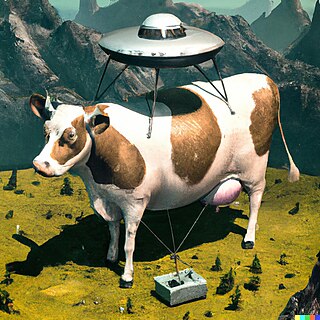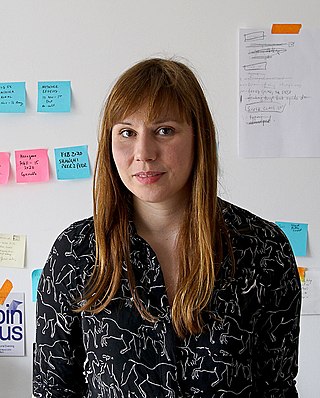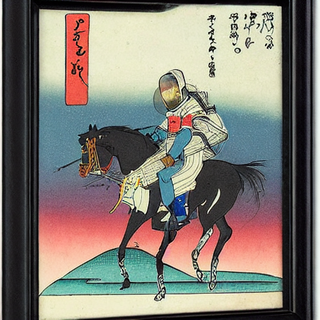
Digital art refers to any artistic work or practice that uses digital technology as part of the creative or presentation process. It can also refer to computational art that uses and engages with digital media.

Karl Sims is a computer graphics artist and researcher, who is best known for using particle systems and artificial life in computer animation.
Kenneth E. Rinaldo is an American neo-conceptual artist and arts educator, known for his interactive robotics, 3D animation, and BioArt installations. His works include Autopoiesis (2000), and Augmented Fish Reality (2004), a fish-driven robot.
The following outline is provided as an overview of and topical guide to artificial intelligence:
BioArt is an art practice where artists work with biology, live tissues, bacteria, living organisms, and life processes. Using scientific processes and practices such as biology and life science practices, microscopy, and biotechnology the artworks are produced in laboratories, galleries, or artists' studios. The scope of BioArt is a range considered by some artists to be strictly limited to "living forms", while other artists include art that uses the imagery of contemporary medicine and biological research, or require that it address a controversy or blind spot posed by the very character of the life sciences.

Mark Stephen Meadows (born September 28, 1968), known by his artist name, pighed, is an American author, inventor and artist.

Hybrid art is a contemporary art movement in which artists work with frontier areas of science and emerging technologies. Artists work with fields such as biology, robotics, physical sciences, experimental interface technologies, artificial intelligence, and information visualization. They address the research in many ways such as undertaking new research agendas, visualizing results in new ways, or critiquing the social implications of the research. The worldwide community has developed new kinds of art festivals, information sources, organizations, and university programs to explore these new arts.

Bill Vorn is a Canadian artist, musician and professor known for his robotic artworks. Vorn was also a member of the band Rational Youth from 1981 to 1983.

Joy Adowaa Buolamwini is a Ghanaian-American-Canadian computer scientist and digital activist based at the MIT Media Lab. She founded the Algorithmic Justice League (AJL), an organization that works to challenge bias in decision-making software, using art, advocacy, and research to highlight the social implications and harms of artificial intelligence (AI).

Angelo Dalli is a computer scientist specialising in artificial intelligence, a serial entrepreneur, and business angel investor.

Artificial intelligence art is any visual artwork created through the use of artificial intelligence (AI) programs.
Maja Smrekar is a Slovenian intermedia artist. In 2005 she graduated at the Department for Sculpture of Fine Art and Design Academy in Ljubljana. She also holds Master's degree in Video and New Media that she obtained at the same institution. She has exhibited in numerous institutions across the world. In 2017 she received the Golden Nica award at the Ars Electronica festival for her K-9_topology series. In this opus, which consist of four projects she addressed the topics of parallel evolution of human and dog. From 2008 she is a featured artist and production partner of Kapelica Gallery in Ljubljana.

Ai-Da is "the world's first ultra-realistic humanoid robot". Completed in 2019, Ai-Da is an android incorporating computer graphics and artificial intelligence algorithms that makes drawings, paintings, and sculptures. She is named after Ada Lovelace.
Stephanie Dinkins is a transdisciplinary American artist based in Brooklyn, New York. She is known for creating art about artificial intelligence (AI) as it intersects race, gender, and history.

Anna Ridler is an artist and researcher who lives and works in London. She works with collections of information or data, particularly self-generated data sets, to create new and unusual narratives in a variety of mediums.
Alexander Reben is an American artist, researcher and roboticist. He is best known for his artworks created in collaboration with artificial intelligence, and his research in robotics. Reben's work has been exhibited widely in the United States and Western Europe, including the Museum of Applied Arts, Vienna and the Charlie James Gallery. His work is included in permanent collection of the MIT Museum. He currently serves as Director of Technology and Research at Stochastic Labs, a Berkeley, California-based nonprofit incubator for artists, scientists and engineers.

Jake Elwes is a British media artist, hacker, neuroqueer and researcher. Their practice is the exploration of artificial intelligence (AI), queer theory and technical biases. They are known for using AI to create art in mediums such as video, performance and installation. Their work on queering technology addresses issues caused by the normative biases of artificial intelligence.

A text-to-image model is a machine learning model which takes an input natural language description and produces an image matching that description.
Espacio Solo – and its accompanying Colección Solo – is a private contemporary art museum in Madrid, founded by Spanish industrialist Ana Gervás and entertainment executive David Cantolla in 2013 and expanded into its current form in 2018. David Cantolla is the founder of Zinkia Entertainment and a BAFTA award winner for the animated series Pocoyo.












